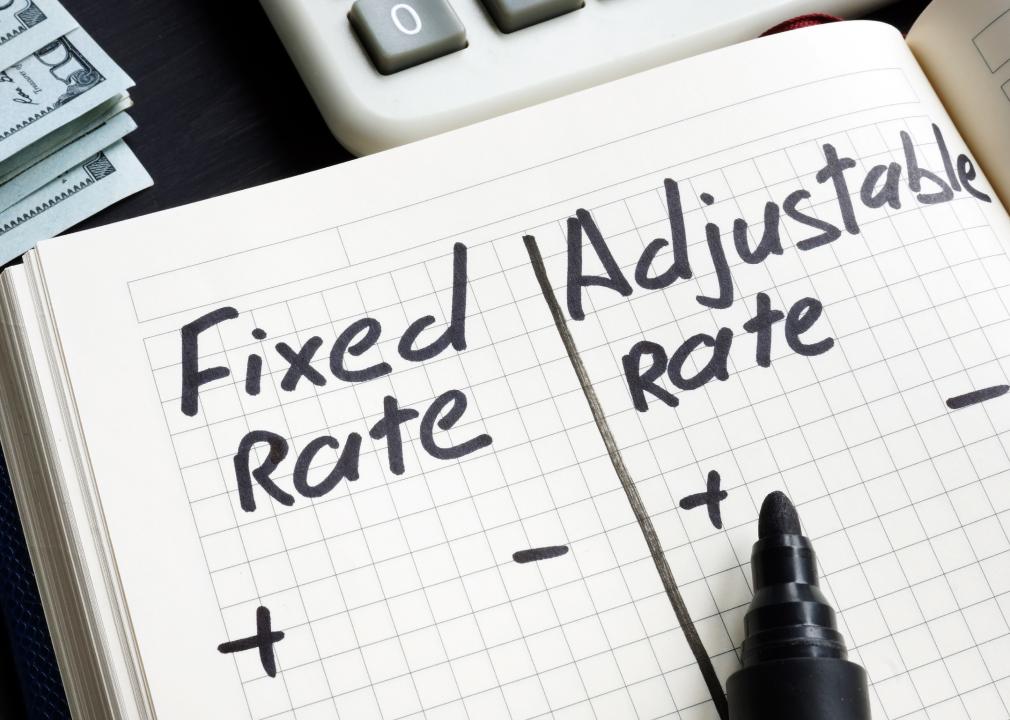Adjustable-rate mortgages, explained
Michael Dechev // Shutterstock
Adjustable-rate mortgages, explained
Mortgage rates have been historically low for the last few years, but they are on the rise. As interest rates inch up, adjustable-rate mortgages often become more attractive for some homebuyers. With 30-year fixed-rate loans sitting at 4.67%, the highest interest rate since 2018, the rate on one popular adjustable-rate mortgage is 3.5%.
As its name indicates, the interest rate a homeowner pays with an adjustable-rate mortgage changes over the life of the loan. After an introductory period, during which the rate is fixed and typically lower than that offered by a fixed-rate mortgage, the rate can go up or down. And that carries risk.
Borrowers avoided adjustable-rate mortgages after the housing market crash in 2008, but guidelines put in place since then require lenders to consider homebuyers’ ability to repay mortgages over the entirety of the loan, not just at the introductory rate. In 2022, interest rates are rising as home prices continue to soar, so the centralized banking system in the United States—its Federal Reserve—has raised a key interest rate to try to bring inflation under control.
To explain the mortgage market, real estate platform ZeroDown compiled a list of facts on adjustable-rate mortgages, including what they are, how they differ from fixed-rate mortgages, which factors affect interest rates and monthly payments in an adjustable-rate mortgage, and who can benefit from this type of mortgage.
![]()
Vitalii Vodolazskyi // Shutterstock
Differences between adjustable-rate mortgages and fixed-rate mortgages
The key difference between an adjustable-rate mortgage and a fixed-rate mortgage can be explained in the names: a rate that changes and adjusts versus a rate that stays fixed and static. The interest rate paid on an adjustable-rate mortgage can rise and fall, while the one on the fixed-rate mortgage is determined when the loan is taken out. It will not change over the life of the loan. An adjustable-rate mortgage will typically begin at a lower rate than a fixed-rate mortgage for an introductory period, but once that period ends, the rate fluctuates. Depending on the chosen mortgage, the introductory period can last for as little as a month, or for up to five or more years.
fizkes // Shutterstock
Components of an adjustable-rate mortgage
Adjustable-rate mortgages have a number of components, among them an introductory interest rate period, an index, a margin, interest-rate caps, and payment caps. Once an introductory period ends, the interest rate is determined by adding a margin to an index. Those margins, which are agreed upon at the time of the loan application, can vary by lender, and the interest rate changes as the index fluctuates.
Some common indexes include the rates on one-year Constant Maturity Treasury securities, the Cost of Funds Index, and the Secured Overnight Financing Rate. An interest rate cap, either annual or over the life of the loan, offers some protection against large interest rate changes. A payment cap can limit the amount that monthly payments increase with each adjustment.
gpointstudio // Shutterstock
Types of adjustable-rate mortgages
Anyone considering an adjustable-rate mortgage can choose from several different types. A hybrid adjustable-rate mortgage offers a mix of periods at a fixed-rate and an adjustable-rate, for example, one that offers five years of a fixed rate after which it might adjust each year. That would be described as a 5/1 adjustable-rate mortgage, with the first number referring to the length of the fixed rate and the second number indicating how often the rate can adjust each year after the fixed-rate term ends.
With an interest-only adjustable-rate mortgage, only interest can be paid for a number of years, typically three to 10, giving a borrower a smaller monthly payment over that period.
A payment-option adjustable-rate mortgage provides the flexibility to choose what kind of payment to make each month. The choices are typically a payment of principal and interest; a payment of only interest; or a minimum or limited payment that might not cover the interest, with the difference added to the loan’s principal.
fizkes // Shutterstock
Who should get an adjustable-rate mortgage?
Adjustable-rate mortgages carry more risk once the introductory period ends if the interest increases—and this can make budgeting more challenging. That said, adjustable-rate mortgages can make sense for owners who plan to stay in their homes for a shorter period of time. If, for example, you are in the military or have a contract with an employer and expect to move after five or so years, you would pay only the lower introductory interest rate.
Or, with a lower interest rate, you might be able to pay off more of the principal faster, assuming that the mortgage does not include early payoff penalties. If you plan to sell your home or refinance in the future, watch out for repayment penalties.
fizkes // Shutterstock
How rising interest rates can affect mortgage payments
In March 2022, the Federal Reserve announced a quarter of a percentage point increase on its key rate, which is the interest that banks can be charged for overnight loans. The Federal Reserve also indicated that to curb inflation, other increases are likely before the end of the year. Because many adjustable-rate loans are now tied to the Secured Overnight Financing Rate and because that rate is affected by the Federal Reserve’s decisions, those mortgage rates will rise or fall.
With the average rate of a 30-year fixed-rate mortgage well above the average rate of a 5/1 adjustable-rate mortgage, for example, the adjustable-rate mortgage is looking more attractive to many homebuyers. Remember, however, that an adjustable-rate mortgage carries more risk once the introductory period expires.
This story originally appeared on ZeroDown
and was produced and distributed in partnership with Stacker Studio.






